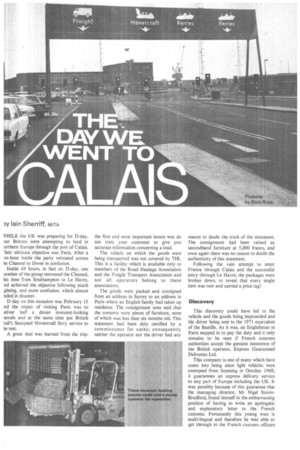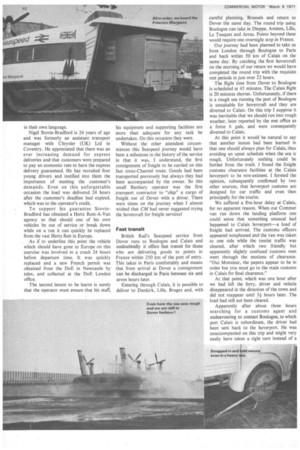Dy lain Sherriff, MITA
Page 41

Page 42

Page 43

If you've noticed an error in this article please click here to report it so we can fix it.
VHILE the UK was preparing for D-day, our Britons were attempting to land in orthern Europe through the port of Calais. "heir ultimate objective was Paris. After a ye-hour battle the party retreated across he Channel to Dover in confusion.
Inside 48 hours, in fact on D-day, one aember of the group recrossed the Channel, his time from Southampton to Le Havre, nd achieved the objective following much ghting, and more confusion, which almost nded in disaster.
D-day on this occasion was February 15 nd the object of visiting Paris was to leliver half a dozen innocent-looking iarcels and at the same time put British Lail's Seas peed Hovercraft ferry service to he test.
A great deal was learned from the trip: the first and most important lesson was do not trust your customer to give you accurate information concerning a load.
The vehicle on which the goods were being transported was not covered by TIR. This is a facility which is available only to members of the Road Haulage Association and the Freight Transport Association and not all operators belong to these associations.
The goods were packed and consigned from an address in Surrey to an address in Paris where an English family had taken up residence. The consignment note said that the contents were pieces of furniture, none of which was less than six months old. This statement had been duly certified by a commissioner for oaths; consequently neither the operator nor the driver had any reason to doubt the truth of the statement. The consignment had been valued as secondhand furniture at 5,000 francs, and once again there was no reason to doubt the authenticity of this statement.
Following the vain attempt to enter France through Calais and the successful entry through Le Havre, the packages were broken down, to reveal that every single item was new and carried a price tag!
Discovery This discovery could have led to the vehicle and the goods being impounded and the driver being sent to the 1971 equivalent of the Bastille. As it was, an Englishman in Paris stepped in to pay the duty and it only remains to be seen if French customs authorities accept the genuine innocence of the British operator, Express Guaranteed Deliveries Ltd.
This company is one of many which have come into being since light vehicles were exempted from licensing in October 1968; it guarantees an express delivery service to any part of Europe including the UK. It was possibly because of this guarantee that the managing director, Mr Nigel StovinBradford, found himself in the embarrassing position of having to write an apologetic. and explanatory letter to the French customs. Fortunately this young man is multi-lingual and therefore he was able to get through to the French customs officers
in their own language.
Nigel Stovin-Bradford is 24 years of age and was formerly an assistant transport manager with Chrysler (UK) Ltd in Coventry. He appreciated that there was an ever increasing demand for express deliveries and that customers were prepared to pay an economic rate to have the express delivery guaranteed. He has recruited four young drivers and instilled into them the importance of meeting the customer's demands. Even on this unforgettable occasion the load was delivered 24 hours after the customer's deadline had expired, which was to the operator's credit.
To support his guarantee StovinBradford has obtained a Hertz Rent-A-Van agency so that should one of his own vehicles be out of service or break down while on a run it can quickly be replaced from the vast Hertz fleet in Europe.
As if to underline this point the vehicle which should have gone to Europe on this exercise was involved in a crash 24 hours before departure time. It was quickly replaced and a new French permit was obtained from the DoE in Newcastle by telex, and collected at the DoE London office.
The second lesson to be learnt is surely that the operator must ensure that his staff, his equipment and supporting facilities are more than adequate for any task he undertakes. On this occasion they were.
Without the other attendant circumstances this Seaspeed journey would have been a milestone in the history of the service in that it was, I understand, the first consignment of freight to be carried on this fast cross-Channel route. Goods had been transported previously but always they had been accompanied by the owner. So this small Banbury operator was the first transport contractor to "ship" a cargo of freight out of Dover with a driver. There were times on the journey when I almost wished that CM had never suggested trying the hovercraft for freight services!
Fast transit British Rail's Seaspeed service from Dover runs to Boulogne and Calais and undoubtedly it offers fast transit for those who are delivering goods to points in France within 250 km of the port of entry. This takes in Paris comfortably and means that from arrival at Dover a consignment can be discharged in Paris between six and seven hours later.
Entering through Calais, it is possible to deliver to Dunkirk, Lille, Bruges and, with
careful planning, Brussels and return to Dover the same day. The round trip using Boulogne can take in Dieppe, Amiens, Lille, Le Touquet and An-as. Points beyond these would require one overnight stop in France.
Our journey had been planned to take us from London through Boulogne to Paris and back within 50 km of Calais on the same day. By catching the first hovercraft on the morning of our return we would have completed the round trip with the requisite rest periods in just over 22 hours.
The flight time from Dover to Boulogne is scheduled at 45 minutes. The Calais flight is 20 minutes shorter. Unfortunately, if there is a rough sea running the port of Boulogne is unsuitable for hovercraft and they are diverted to Calais. On this trip I suppose it was inevitable that we should run into rough weather, later reported by the met office as a force 6 gale, and were consequently diverted to Calais.
At this point it would be natural to say that another lesson had been learned in that one should always plan for Calais, thus avoiding an upset schedule when the sea is rough. Unfortunately nothing could be further from the truth. I found the freight customs clearance facilities at the Calais hoverport to be non-existent. I formed the opinion, subsequently confirmed by two other sources, that hoverport customs are designed for car traffic and even then principally for the tourist.
We suffered a five-hour delay at Calais, for no apparent reason. When our Commer van ran down the landing platform one could sense that something unusual had happened to Calais hoverport—a load of freight had arrived. The customs officers appeared nonplussed and the van was taken to one side while the tourist traffic was cleared, after which two friendly but apparently slightly confused customs men went through the motions of clearance. "Oui Monsieur, the papers appear to be in order but you must go to the main customs in Calais for final clearance."
At that point, which was one hour after we had left the ferry, driver and vehicle disappeared in the direction of the town and did not reappear until 34 hours later. The load had still not been cleared.
Apparently after about three hours searching for a customs agent and endeavouring to contact Boulogne, to which port Calais is subordinate, the driver had been sent back to the hoverport. He was unaccompanied on this trip and might very easily have taken a right turn instead of a
left and headed straight for Paris. So far as the customs officials were aware he could have been carrying three tons of hashish. They had not opened the goods and their only point of dispute was that the consignment notes should have confirmed that the furniture was not less than two year old instead-of the certified six months.
They demanded a payment of £500 before the load Could be granted official clearance. This £500 they said would be repaid in Paris. "Simple", said Stovin-Bradford. "We will telex my bank and have the money transferred to a French bank in London". On any other day this would have been a perfect solution, but this was D-day and the banks were closed.
At this point the customs men left us alone; they ignored us and again it would have been a simple matter to have slipped off into the gathering gloom with our "illicit" load.
Despite the fact that Seaspeed's staff at Dover and Calais have not been in the habit of handling freight loads they proved themselves most efficient as each incident approached crisis level. A cross-Channel telex message, a 'phone call to a Calais customs agent and even a description of the back-doubles of Calais, which would cut running time, were all supplied by a member of the company's terminal staff.
At one point while our driver was delayed at customs and when we thought that some other fate had befallen him, the Seaspeed staff contacted the police, vehicle repairers and the local Hertz agency. There is no question about Seaspeed's ability to handle freight traffic; it is unfortunate that the advantages which can be achieved in using the service are lost at the customs barriers. If anyone has a lesson to learn from this I should think it would be the Calais chamber of commerce.With perhaps a little pressure from British Rail the barriers might be lubricated.
The SRN 4 Hovercraft will not normally accommodate a vehicle over 16ft. long and the maximum height is 10ft. 1 lin. Total laden weight should not be more than about 10 tons. In fact the craft is ideally suited for the types of vehicles used on light, fast deliveries. Rates are calculated on the same basis as the conventional roll-on/roll-off ferry at £1.10 per linear foot for a loaded vehicle or £1.60 for a loaded trailer, Empty trailers and vehicles cost £0.89 per linear foot.
During the trip it occurred to me that in a rough sea (and in most cases freight would travel in winter when passenger traffic is light) it would be essential to have the load well secured within the vehicle, which is itself secured to the deck.
Since the journey is so short there is no refreshment service but duty free facilities are available.
While the existing hovercraft service is ideally suited for light freight, as the principle develops I would expect to see heavier vehicles including coaches using it to make a quick return trip to northern France. This is a view shared by Nigel Stovin-Bradford who, despite this unfortunate first experience, intends to make use of the service again.
They shall pass!




































































































